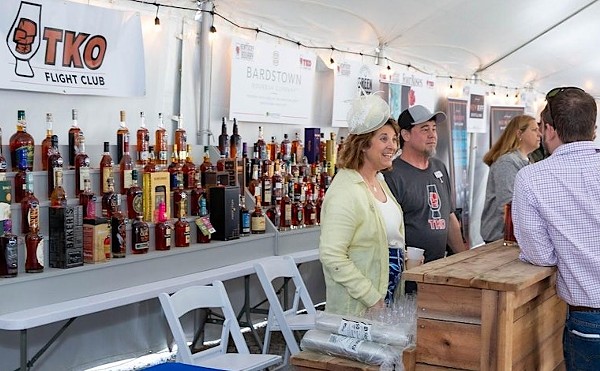Sun Gods in the Shade:
An Evening of Sketch Comedy

The 18th century German novelist and dramatist Johann von Goethe once said, “Thinking is easy, acting is difficult, and to put one’s thoughts into action is the most difficult thing in the world.”
During the 1950s, American thespians increasingly put their thoughts into action on stage, almost instantaneously, with the rise of improvisational theater. While it has its roots in commedia dell’arte, improv morphed into a postmodern animal with its rise in popularity, mostly in Chicago through the work of Viola Spolin and, later, her son Paul Sills, who helped found The Compass Players and The Second City. It used humor to depict the depravity of modern life. Rather than crying at the world, as did Goethe and his compatriots in the sturm und drang set, American improv laughed at the world.
The newest group in Louisville to take up this Chicago-launched legacy is The Indicators. Their aesthetic statement declares, “We hope to uncover a few of the complex oddities that make life beautiful, interesting and, most importantly, side-splittingly funny.” They put that mission on stage with 17 skits developed using improvisational techniques.
Their current show begins with an uneven skit, “The Founding Fathers,” written by artistic director James Cronin. The setting: a keg party hosted by Thomas Jefferson. It’s typical of a college party — peppered with lurid language that might burn any sailor’s ears and much passing around of ganja. Some jokes bordered on bad taste, particularly the comment about Jefferson’s hand roaming into the brownie jar. The skit’s only merit was that it boldly demonstrated that The Indicators are not afraid to be crass.
Brandon Meeks and Erin Crites were the evening’s stand-out performers. Meeks, as Dr. Quivers, had his mad doctor down to a science in “The Fratastic Four,” by Ben Owens and Lindsay Carter. As a leader of a teenage satanic cult in “Not Without My Satan,” which he also wrote, Meeks excelled in unveiling his character as a sniveling geeky kid. One of the highlights was how he could turn his whole face red, connoting the intense anger his satanic character struggled to stifle.
Like Meeks, Crites is chameleon-like in her acting. Her portrayal of a robbery victim in the superhero stint “Dateline: Hustleman,” by Robert Greene, saved the weak storyline. Her character’s bimbo voice could make Paris Hilton sound smart. But Crites also can be serious, as in the sketch “Big Kid,” by Matt Gifford.
The most creative and witty of the sketches were “Not Without My Satan” and “Sam Sam” (Meeks). They related more to the audience and could have slipped down into the land of “wah-wah-wah.” Ridiculing sexually-frustrated teens and GPS systems could have become comedic kitsch, but it didn’t.
Some of the other sketches were as sour as expired milk, notably “Batman,” by Neil Mulac. The catch phrase The Indicators use — “quit beating a dead horse” — could have crossed many minds because the running gag of Bruce Wayne as Batman stretched on too long. Also, some sketches had conflicting themes: “Dateline: Hustleman” played on African-American urban classification, while “Diversion Politician,” by James Cronin, and “Visitors,” by Gifford, exposed the ignorance of stereotyping.
The show ended on a high note with “Clowns … Oh My!,” by Owens. It turned the subject of writer’s block into a truly comical sketch. This showed the heart of improvisation — throwing clowns, Mayans and mimes together in a single skit, making the evening worth the time and the $7 ticket price.





